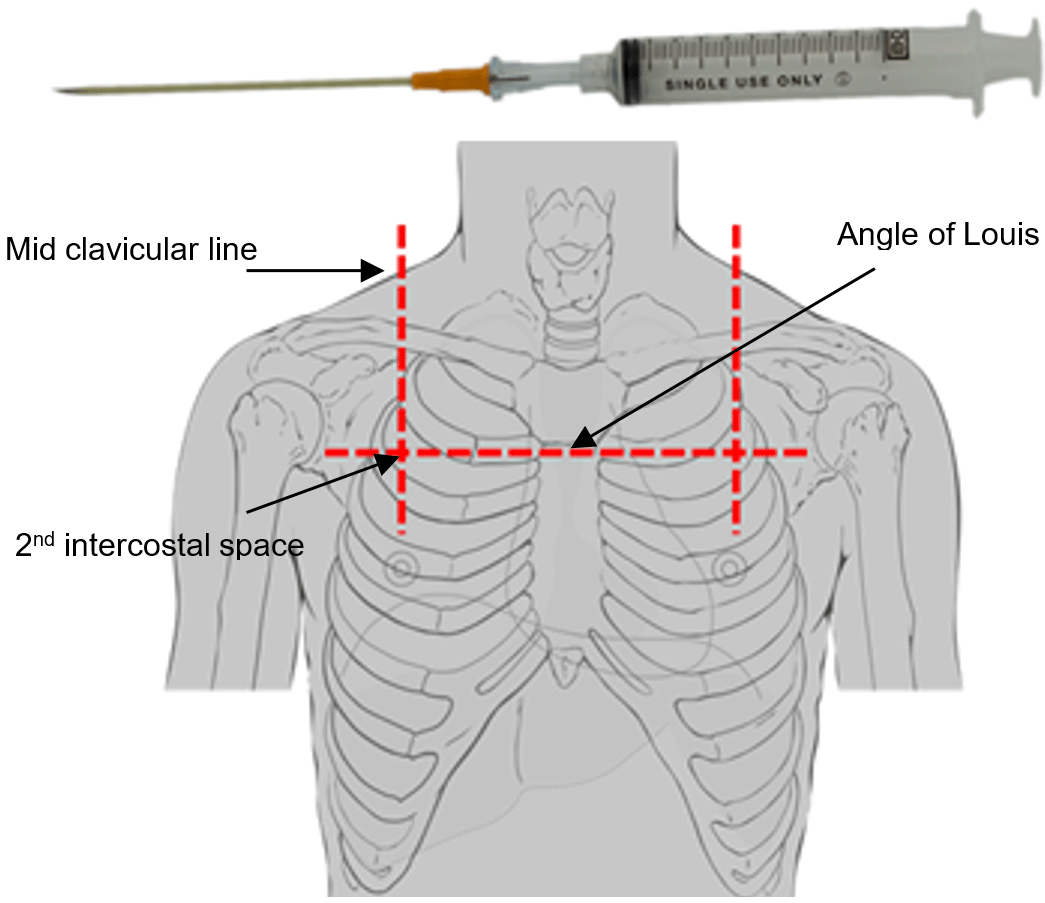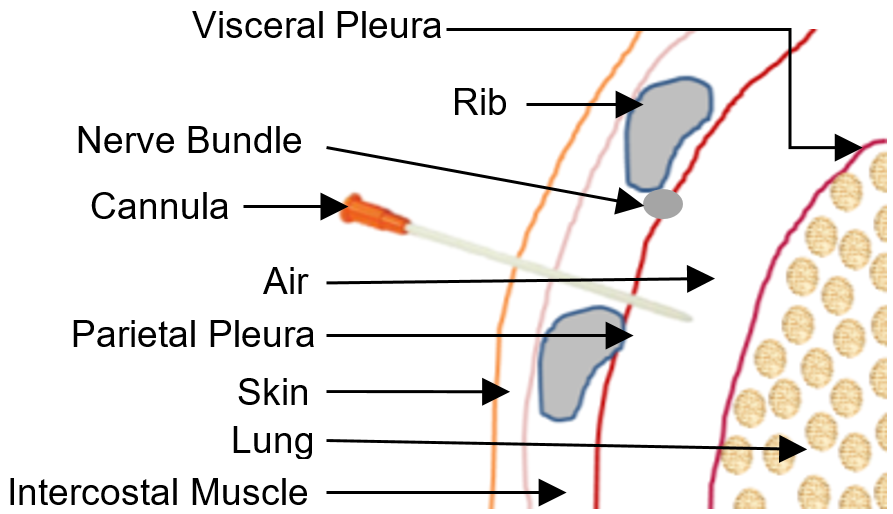
- Traumatic cardiac arrest with torso involvement
- Suspected tension pneumothorax with respiratory and/or haemodynamic compromise
- Patients not in cardiac arrest unless trained and authorised
- Consider ASMA consult in a patient with suspected tension pneumothorax and respiratory and/or haemodynamic compromise.
- Perform bilaterally in traumatic cardiac arrest
- A patient not in cardiac arrest can receive unilateral treatment on the affected side, with ASMA authorisation where applicable
- The site selected should be superior to the third rib to avoid trauma to intercostal blood vessels and nerves.
- Procedure can be repeated if tension pneumothorax redevelops.
- It is very difficult to detect breath sounds/chest rise and fall in Traumatic Cardiac Arrest, so tension pneumothorax should be assumed whenever there is trauma to the torso
- Use of the ARS 10g needle is the preferred item, however the 14g needle can also be utilised.
- Shorter cannulas are unlikely to penetrate into the plural space
- All relevant infection control methods to be utilised.
- Prepare equipment required:
- Alcohol/betadine swab
- ARS 10g needle or Angio Cath 14g needle**
- 10mL syringe & NaCl
- Stethoscope
** Use an alternative size needle if the primary item is obviously too long for the anatomical features of the patient (e.g. younger / frail etc.)
- Locate the specific landmark on the affected side: 2nd intercostal space, mid-clavicular line.
- Clean the landmark site with an alcohol/betadine swab.
- Connect the thoracocentesis needle to the 10mL syringe.
- Insert the needle at a 90° angle to the patient’s chest wall.
- While inserting the needle, aspirate the 10mL syringe. Resistance is felt until the cannula enters the pleural space and releases air and/or fluids.
- Repeat procedure for opposing pleura.
- Remove the needle leaving the cannula in place.
- Re-evaluate the patient.
- Auscultate the chest.
- If found that the pneumothorax re-tensions:
- Repeat the procedure leaving the initial cannula in situ.
- Insert second cannula immediately adjacent to the first.


- In noisy high-stress environments, release of air may be difficult to detect. Signs of success include an improving SpO2, easing respiratory effort and decreased airway pressures in ventilated patients.
- Document pertinent points as necessary
- Improper diagnosis and insertion of a pleural catheter may lead to the creation of a pneumothorax or tension pneumothorax
- Incorrect placement may result in life threatening injuries to the heart, lung or surrounding vessels.
| Settings | |
|---|---|
| Extended Care: | |
| Colour assist: | |
Document Control
Clinical Resources Website
St John Ambulance Western Australia Ltd (ABN 55 028 468 715) (St John WA) operates ambulance and other pre-hospital clinical services. St John WA’s Clinical Resources, including its Clinical Practice Guidelines (Clinical Resources), are intended for use by credentialed St John WA staff and volunteers when providing clinical care to patients for or on behalf of St John WA, within the St John WA Clinical Governance Framework, and only to the extent of the clinician’s authority to practice.
Other users – Terms of Use
The content of the St John WA Clinical Resources is provided for information purposes only and is not intended to serve as health, medical or treatment advice. Any user of this website agrees to be bound by these Terms of Use in their use of the Clinical Resources.
St John WA does not represent or warrant (whether express, implied, statutory, or otherwise) that the content of the Clinical Resources is accurate, reliable, up-to-date, complete or that the information contained is suitable for your needs or for any particular purpose. You are responsible for assessing whether the information is accurate, reliable, up-to-date, authentic, relevant, or complete and where appropriate, seek independent professional advice.
St John WA expressly prohibits use of these Clinical Resources to guide clinical care of patients by organisations external to St John WA, except where these organisations have been directly engaged by St John WA to provide services. Any use of the Clinical Resources, with St John WA approval, must attribute St John WA as the creator of the Clinical Resources and include the copyright notice and (where reasonably practicable) provide a URL/hyperlink to the St John WA Clinical Resources website.
No permission or licence is granted to reproduce, make commercial use of, adapt, modify or create derivative works from these Clinical Resources. For permissions beyond the scope of these Terms of Use, including a commercial licence, please contact medservices@stjohnambulance.com.au
Where links are provided to resources on external websites, St John WA:
- Gives no assurances about the quality, accuracy or relevance of material on any linked site;
- Accepts no legal responsibility regarding the accuracy and reliability of external material; and
- Does not endorse any material, associated organisation, product or service on other sites.
Your use of any external website is governed by the terms of that website, including any authorisation, requirement or licence for use of the material on that website.
To the maximum extent permitted by law, St John WA excludes liability (including liability in negligence) for any direct, special, indirect, incidental, consequential, punitive, exemplary or other loss, cost, damage or expense arising out of, or in connection with, use or reliance on the Clinical Resources (including without limitation any interference with or damage to a user’s computer, device, software or data occurring in connection with such use).
Cookies
Please read this cookie policy carefully before using Clinical Resources from St John WA.
The cookies used on this site are small and completely anonymous pieces of information and are stored on your computer or mobile device. The data that the cookies contain identify your user preferences (such as your preferred text size, scope / skill level preference and Colour Assist mode, among other user settings) so that they can be recalled the next time that you visit a page within Clinical Resources. These cookies are necessary to offer you the best and most efficient possible experience when accessing and navigating through our website and using its features. These cookies do not collect or send analytical information back to St John WA.
Clinical Resources does integrate with Google Analytics and any cookies associated with this service enable us (and third-party services) to collect aggregated data for statistical purposes on how our visitors use this website. These cookies do not contain personal information such as names and email addresses and are used to help us improve your user experience of the website.
If you want to restrict or block the cookies that are set by our website, you can do so through your browser setting. Alternatively, you can visit www.internetcookies.com, which contains comprehensive information on how to do this on a wide variety of browsers and devices. You will find general information about cookies and details on how to delete cookies from your device. If you have any questions about this policy or our use of cookies, please contact us.